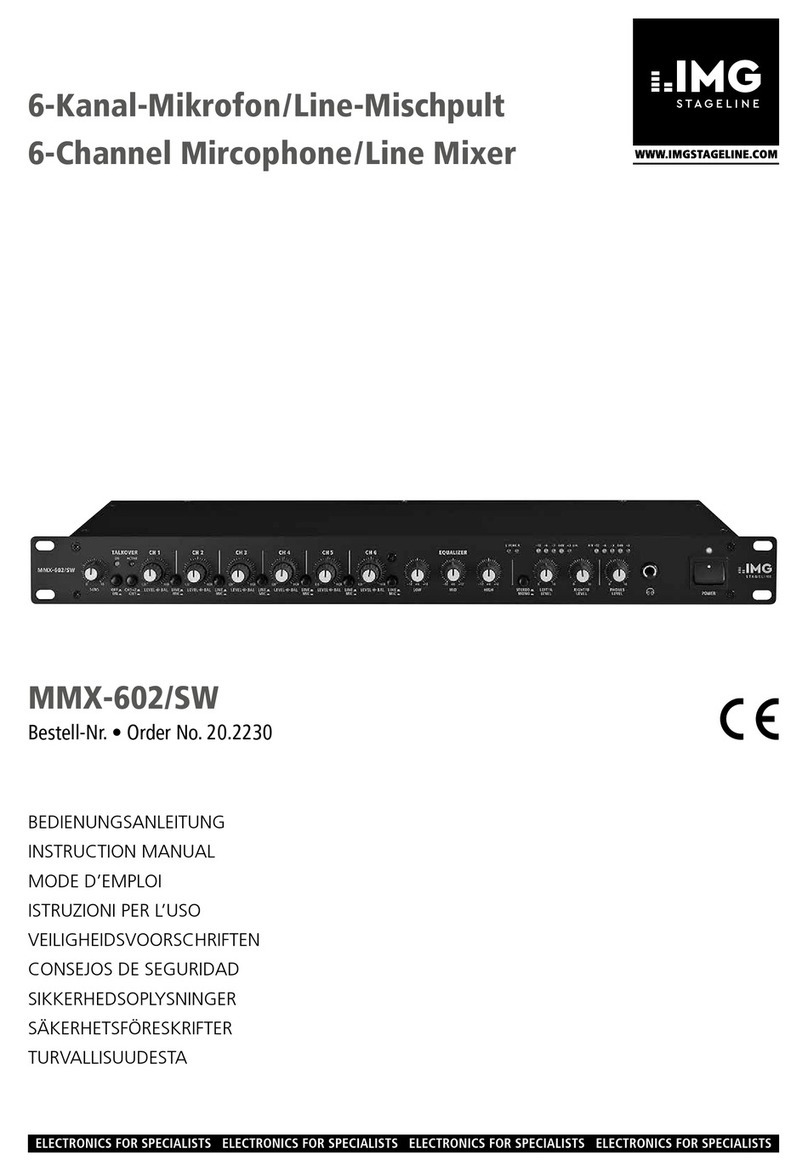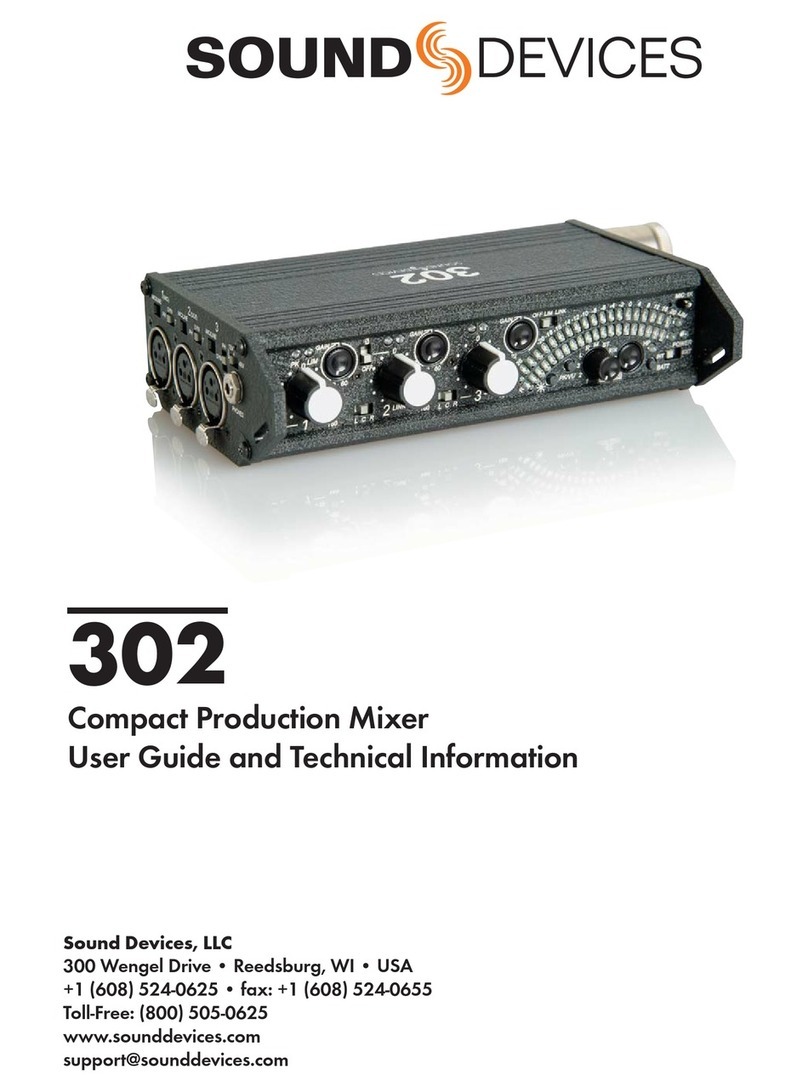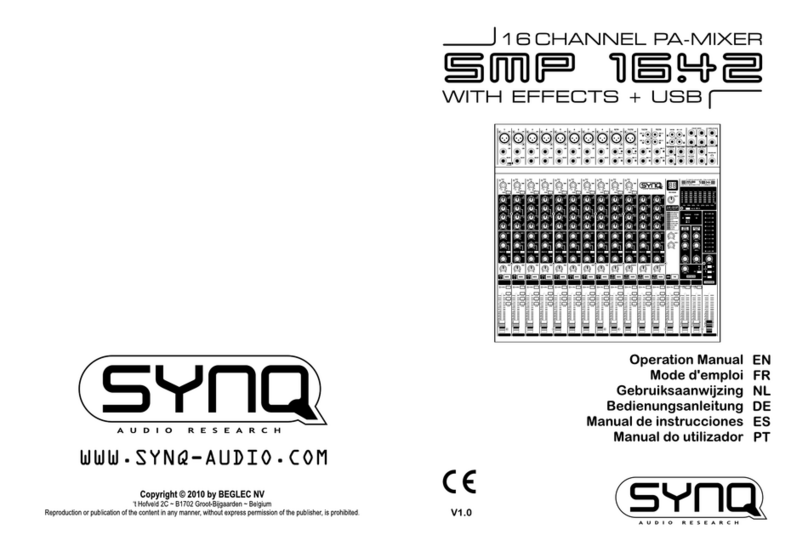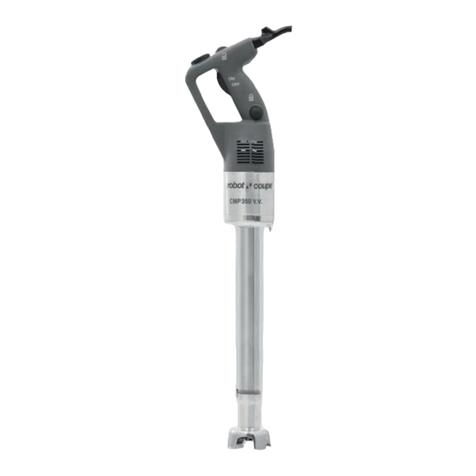5.8 Poussoir pour
déclenchement de gong
On peut mixer un gong (CHIME) aux signaux
des entrées CH1 à CH4 par un contact de fer-
meture. Trois tonalités sont sélectionnables
(chapitre 5.8.1). Pour déclencher le gong,
reliez par exemple un poussoir au contact cor-
respondant des bornes à vis CHIME INPUT 1/2/
3/4 (25) et le contact commun G :
⑨Branchement poussoir gong
5.8.1 Sélection de la tonalité du gong
La tonalité du gong peut être réglée dans le
mixeur. Vous pouvez choisir entre une suite de
deux tons, de quatre tons et une sirène. La
sirène est un signal d'urgence selon la norme
DIN 33 404/EN 457.
1) Retirez le couvercle du boîtier du mixeur.
2) Vous trouverez à l'intérieur, parallèle à la
face arrière de l'appareil, une platine avec
cavalier à proximité des entrées pour CH1 et
PAGING. Mettez le cavalier sur la position
correspondante à la tonalité voulue :
⑩Sélection du gong
3) Refermez le boîtier.
5.9 Alimentation et
alimentation de secours
Si le mixeur doit continuer à fonctionner en cas
de coupure de courant, il faut relier une unité
d'alimentation de secours 24 V (p. ex. PA-24ESP
de MONACOR) aux bornes 24 V(15). Pour
finir, reliez la prise secteur (13) via le cordon sec-
teur livré à une prise secteur 230 V~/50 Hz.
Conseil : lorsque la tension 24 V est appliquée, le
mixeur est aussitôt en fonction, le témoin de fonction-
nement (11) brille. Le mixeur ne peut pas être éteint
avec l'interrupteur POWER (12). L'interrupteur com-
mute uniquement entre alimentation secteur et alimen-
tation de secours.
6 Utilisation
1) Pour éviter tout volume trop élevé, mettez les
réglages de zones Z1 – Z4 (9) sur “0” avant
d'allumer l'appareil pour la première fois.
2) Allumez en premier les sources audio reliées
puis le PA-6040MPX avec l'interrupteur
POWER (12). Le témoin de fonctionnement
(11) brille. Allumez les amplificateurs reliés
au PA-6040MPX en dernier.
Après le fonctionnement, éteignez les
amplificateurs en premier.
3) Comme réglage de base, mettez tout d'abord
tous les réglages pour les entrées LEVEL
(8) et les réglages de tonalité (1) sur la posi-
tion médiane.
4) Tournez les réglages pour les sorties utili-
sées Z1 – Z4 (9) jusqu'à ce que les réglages
suivants soient correctement audibles via les
enceintes.
5) Avec les sélecteurs Z1 – Z4 (2), définissez
pour chaque entrée vers quelle sortie (dans
quelle zone de sonorisation) son signal doit
être dirigé. Si un signal est présent à l'entrée,
la LED SIG (7) brille. Si la LED ne brille pas,
augmentez le niveau de sortie des sources
audio ou, pour des canaux CH1 à CH4, corri-
gez lʼamplification dʼentrée avec le réglage
GAIN (23) au-dessus de la prise dʼentrée.
Mixez les signaux d'entrée avec les
réglages de volume correspondants LEVEL
(8) ou, si besoin, coupez et activez leur son.
Si une source audio n'est pas utilisée,
mettez le réglage LEVEL de son canal d'en-
trée sur “0”.
6) Avec les réglages de sortie Z1 – Z4 (9),
réglez le volume souhaité pour la zone de
sonorisation correspondante.
Le niveau de chaque sortie est indiqué par
les LEDs −13, −8, −3, 0 dB et CLIP (3). Si la
LED CLIP brille, la sortie est en surcharge.
Dans ce cas, tournez le réglage (9) pour cette
sortie en conséquence ou diminuez le
volume du signal d'entrée avec le réglage
LEVEL (8).
7) Réglez la tonalité avec les réglages (1)
TREBLE pour les aigus et BASS pour les
graves. Si besoin, corrigez le réglage de
volume.
6.1 Contrôle des sorties
Les signaux des sorties peuvent être vérifiés via
un système moniteur relié à la prise MONITOR
(20).
1) Avec le sélecteur REC/MONITOR (5), sélec-
tionnez la sortie qui doit être contrôlée. En
position OFF, aucune sortie n'est sélection-
née.
2) Avec le réglage LEVEL (6), réglez le volume
souhaité.
Conseil : les prises de sortie REC (19) reçoivent le
même signal que la prise MONITOR (20).
6.2 Déclenchement du gong
Si un gong doit retentir, par exemple pour pré-
venir d'une annonce via une des entrées
CH1 – CH4, appuyez brièvement sur le poussoir
correspondant, relié aux bornes (25) (chapi-
tre 5.8). Le gong est mixé au signal d'entrée,
mais son volume ne dépend pas du réglage
LEVEL (8) du canal d'entrée mais uniquement
du réglage de volume de la sortie (9).
Comme pour une annonce via les entrées
CH1 – CH4, les signaux d'entrée des canaux
d'entrées de rang inférieur, CH5 et CH6, sont
coupés pendant que le gong retentit.
6.3 Microphone de table PA-4000PTT
Pour des annonces avec ce microphone de table :
1) Avec les sélecteurs PAGING/PTT Z1 – Z4 (4),
sélectionnez sur le mixeur les zones de sono-
risation dans lesquelles l'annonce doit être
entendue. Appuyez sur les interrupteurs pour
les zones souhaitées, désenclenchez les
autres.
2) Tournez le réglage pour le volume PAGING/
PTT LEVEL (10) sur le mixeur à la moitié
environ avant la première annonce.
3) Sur le microphone, maintenez la touche
TALK (31) enfoncée et parlez dans la cap-
sule micro (29). La LED de contrôle (30)
brille. Si le volume défini du discours est
dépassé, les signaux d'entrée de rang infé-
rieur sur le mixeur sont automatiquement
coupé (tableau schéma 5, chapitre 3).
4) Si besoin, corrigez le volume de l'annonce
avec le réglage LEVEL-PAGING/PTT. Les
réglages de volume pour les sorties (9) n'ont
pas d'influence.
6.3.1 Réglages sur le PA-4000PTT
Deux petits interrupteurs se trouvent sur la face
arrière du microphone de table :
PRIORITY – pour une utilisation sur le
PA-6040MPX, laissez cet interrupteur sur la
position supérieure puisque la priorité pour
ce microphone est définie sur le mixeur (pour
une meilleure compréhension de l'annonce,
les autres signaux d'entrée sont coupés dès
que l'on parle ou que le gong retentit)
CHIME – en position ON, un gong retentit
lorsque vous appuyez sur la touche TALK
(31) ; la tonalité du gong est la même que
celle déclenchée par un poussoir relié au
mixeur et peut être sélectionnée sur le mixeur
(chapitre 5.8.1)
6.4 Annonce via l'entrée PAGING
Pour une annonce via un appareil relié à l'entrée
PAGING (26) (par exemple microphone avec
préamplificateur ou sortie niveau ligne d'une ins-
tallation téléphonique), procédez comme décrit
au chapitre 6.3. Les réglages sʼappliquent au
microphone de table PA-4000PTT et à lʼentrée
PAGING. Si une annonce est faite simultané-
ment via le microphone de table, le signal à l'en-
trée PAGING et le signal du microphone de
table sont mixés.
6.5 Microphone de commande
PA-4000RC
Pour des annonces avec un PA-4000RC :
1) Tournez le réglage de volume AUDIO LEVEL
(44) sur la face arrière du microphone de
commande à la moitié environ avant la pre-
mière annonce.
2) Avec les touches sous Z1 à Z4 (41), sélec-
tionnez les zones de sonorisation dans les-
quelles l'annonce doit être entendue. La LED
BUSY à côté de la touche brille pour les
zones sélectionnées.
Si une zone doit être désélectionnée,
appuyez à nouveau sur la touche correspon-
dante pour que la LED BUSY sʼéteigne. Pour
ATTENTION Ne réglez pas jamais le
volume trop fort. Un volume
trop élevé peut, à long terme,
générer des troubles de l'audi-
tion. L'oreille humaine s'habi-
tue à des volumes élevés et
ne les perçoit plus comme tels
au bout d'un certain temps.
Nous vous conseillons donc
de régler le volume et de ne
plus le modifier.
Pour éviter les effets de larsen, ne tenez
pas le microphone en direction d'une
enceinte ou trop près d'elle. En cas de
volume réglé trop fort, un larsen peut égale-
ment survenir. Dans ce cas, diminuez le
volume du microphone avec le réglage cor-
respondant.
AVERTISSEMENT Etant donné que le mixeur doit
être ouvert, seul un personnel
qualifié peut le faire. Il est
impératif de débrancher l'ap-
pareil avant toute manipula-
tion, risque de décharge élec-
trique !
17
Français












































